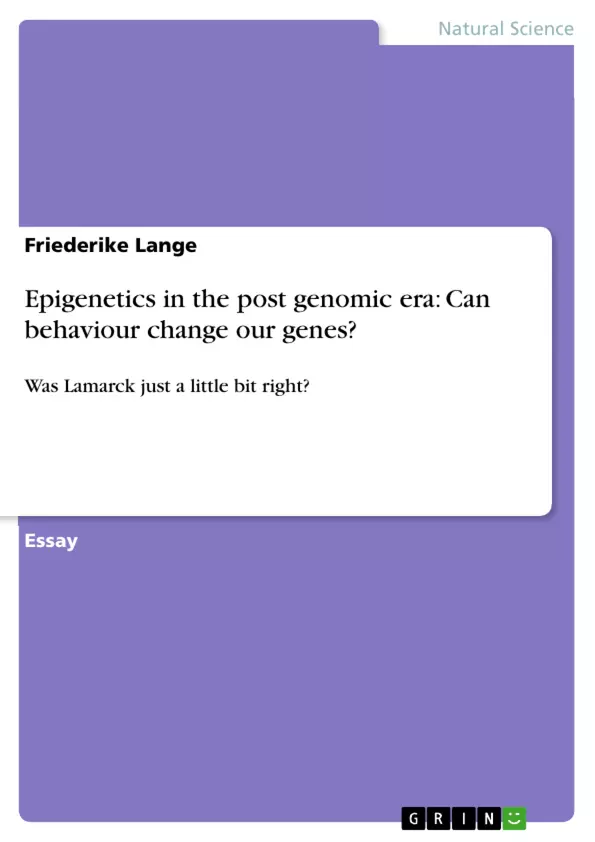Traditionally, genomic research was focused on the investigation of DNA sequence which gives rise to the diversity of phenotypes found in nature. It was undoubted that the information which is given by the genomic sequence is the sole factor which is important for the outcome for each individual organism. But since a few decades, a new concept called epigenetics has arisen and shows that we have to modify our knowledge about genetics. “Epi” derives from Greek meaning “on” or “over” and implies that epigenetic mechanisms act on genes via altering the gene expression and regulation without modifying the actual DNA sequence. In epigenetics, we can find the reason why twins (who have the exact same gene sequence) can alter in their phenotype especially concerning their susceptibility to diseases (Fraga et al. 2005; Wong et al.; 2005). Furthermore, it has the potential to answer the question how phenotypic characteristics can alter between generations without a change in the underlying genetic material.
Inhaltsverzeichnis (Table of Contents)
- Introduction
- Lamarck vs. Darwin
- Epigenetics: Definition and Mechanisms
- Transgenerational Epigenetic/Maternal Effects
- Behaviour Influences and is Influenced by Epigenetics
Zielsetzung und Themenschwerpunkte (Objectives and Key Themes)
This essay aims to explore the field of epigenetics, emphasizing its potential to reconcile seemingly conflicting evolutionary theories. It delves into how epigenetic mechanisms can alter gene expression and regulation without changing the underlying DNA sequence. This exploration also examines the role of epigenetics in phenotypic inheritance, particularly in relation to environmental factors.
- The role of epigenetics in reconciling Lamarckian and Darwinian evolutionary theories
- The mechanisms of epigenetics, including methylation and histone modifications
- The heritability of epigenetic changes and their potential impact on phenotypic variation
- The influence of environmental factors, particularly prenatal experiences, on epigenetic programming
- The interplay between behavior, the epigenome, and social environment
Zusammenfassung der Kapitel (Chapter Summaries)
- Introduction: This section sets the stage for the discussion of epigenetics, highlighting its significance in challenging traditional views of genetics and offering insights into phenotypic variation. It contrasts the focus on DNA sequence in traditional genomics with the emerging understanding of epigenetic mechanisms.
- Lamarck vs. Darwin: This section delves into the historical debate between Lamarck's theory of inheritance of acquired traits and Darwin's theory of natural selection. It highlights how epigenetics offers a modern perspective that bridges these seemingly conflicting ideas.
- Epigenetics: Definition and Mechanisms: This section provides a definition of epigenetics and explores its key mechanisms, particularly methylation and histone modifications. It explains how these mechanisms can regulate gene expression and influence various cellular processes.
- Transgenerational Epigenetic/Maternal Effects: This section examines the long-lasting effects of environmental influences on epigenetic programming, particularly during prenatal development. It uses the example of agouti mice to illustrate how maternal diet and other factors can influence the heritable phenotype of offspring.
- Behaviour Influences and is Influenced by Epigenetics: This section explores the interplay between behavior and epigenetics, highlighting how postnatal experiences can shape the epigenome. It specifically focuses on the glucocorticoid receptor gene in rats and how maternal care-taking behavior can influence stress responses and immune capacity in offspring.
Schlüsselwörter (Keywords)
Epigenetics, gene expression, methylation, histone modifications, transgenerational inheritance, environmental influences, maternal effects, behaviour, social environment, glucocorticoid receptor gene.
- Quote paper
- Friederike Lange (Author), 2011, Epigenetics in the post genomic era: Can behaviour change our genes? , Munich, GRIN Verlag, https://www.grin.com/document/179170



